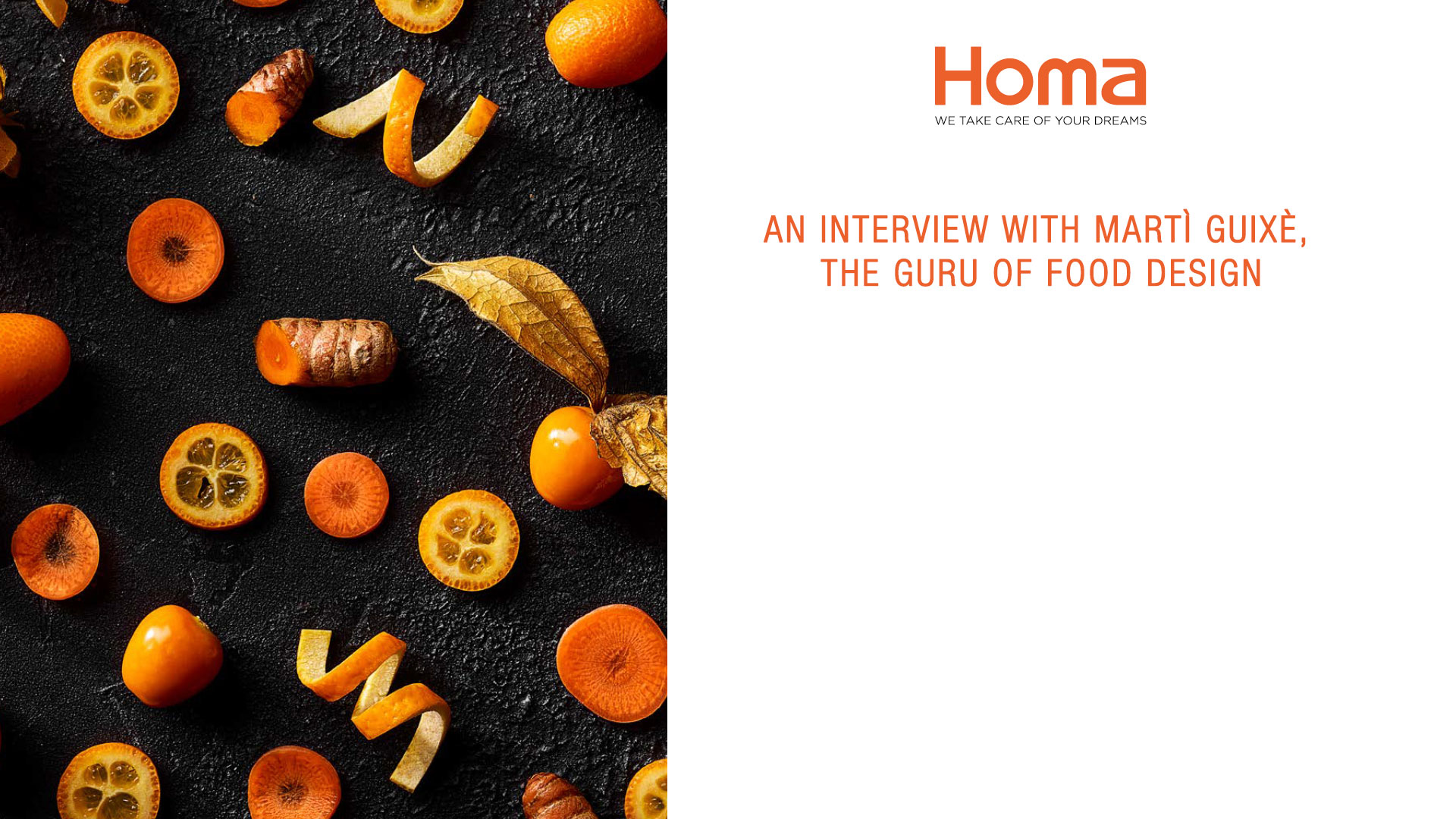

The Catalan designer, or ex-designer as he likes to call himself, Martì Guixè, was the first to apply design principles to food and, to date, is the most revolutionary proponent of this discipline.
Q: You are considered the founder of food design. How did this extraordinary project come about?
A: I started working on food design in1995 when I became fascinated with food and its rituals. I realised that nobody at the time saw food as an object, yet it was already being perceived as such. If food could be considered as an object, it could be treated as a design project. In 1997 I did my first exhibition on the food design theme at the H2Ogallery in Barcelona.
The idea underlying my work in this field is the perception of food as a consumable object, and thus the possibility to engineer it as part of a design project and according to principles such as ergonomics, usability, functionality… all the complexity of such projects can be applied to the food object.
If a chair needs a cushion because it’s uncomfortable, that’s due to a fault in design, a mistake in terms of ergonomics. Likewise, if you need cutlery and a plate to eat, you’re dealing with something that’s been badly designed.
A good edible object shouldn’t need any cutlery nor plates, the issue of how to eat it should already have been solved and the solution built-in in the object itself.
If food is designed in an optimal way in terms of ergonomics, its enjoyment becomes less ritual. For instance, it doesn’t require sitting down at a table to be eaten. Initially, the design community was rather sceptical, so I was adopted by the world of art and lifestyle. This is the reason I call myself an ex-designer: I’m not an artist, I’m really a designer but I don’t work according to the traditional criteria of design.
Q: You also define yourself as a design generalist.
A: Yes, since the beginnings of my career I have worked on several projects that weren’t very specific, possibly because the starting point of my projects is more conceptual, and therefore theory can be translated through any kind of formal expression
Q: What is a food designer, according to Marti Guixè?
A: The most important for me is the design project, thus food is principally an object of experimentation. I always make a distinction between doing and thinking: the design project is pure theory, it’s an exercise of the mind, while doing belongs to the craftsman and has nothing to do with the designer, so the chef has nothing to do with the food designer. Cooking is doing, designing is thinking. The food designer is someone who works with food without having any idea of cooking. I don’t cook, I can’t cook, and I have no intention of learning how to do it. Today, 25 years on, I still haven’t changed my mind.
I’m ever more oriented towards the conceptuality of a project and less focused on its formal contextualisation. The projects I work on are not conceived to be real but are more of an exercise to influence people, to make them think.
Q: In the recent Casa Mondo Food essay, you explain your theory about the relationship between the home, food and its new means of fruition in the 21st Century, also in the light of the current pandemic.
A: Yes, the book features the drawings I made for the Casa Mondo digital exhibition held in June 2020 at the MAXXImuseum in Milan. They reflect the changes in the way we cook and eat at home.
An interesting concept that emerged was the substitution of the figure of the mother as the endower of gastronomic knowledge across the generations by that of the internet, through videos and tutorials. This new non-mother cook, which I called SIC SIRICHEF de Cuisine, is cosmopolitan, chaotic, without any rules and possesses all the information in this world. The consequence is that we will be witnessing a progressive loss of the sense of food geography. The local and regional culinary traditions will get mixed up inexorably, giving birth to anew poli-cosmopolitan cuisine.
Q: You’ve also focussed on the lifestyle changes occurring inside our homes.
A: Exactly, and I would sum it up as follows: similarly, to what happened in 2001, after the terrorist attacks, with the pandemic, we invited the world inside our homes through the social media. We’ve given it hospitality through the food published on Instagram and the online sharing of our recipes.
Consequently, the home, as the object of personal representation, was replaced by food, by what we eat and the way we cook it. Today, our social image is built through food and our own body becomes the formal element of the house. Food has become a stage around which people gather to shoot videos and photos of the dishes they prepare.
Q: Thinking about industrial products, do you think refrigerators are missing anything in terms of food preservation?
A: In 2003 I worked on a project, meta-territorial kitchen”, in which I called the refrigerator “temperature-control”, because its function is not to produce cold but to manage and control temperature and humidity according to the type of foods it contains. We need solutions that are more focussed on a better food preservation. Right now, it’s the mushroom season: I’d love a fridge I could grow my own mushrooms in.
Q: Have you designed one recently?
A: Yes, 5 or 6 years ago I designed a fridge that could produce a one-and-a-half metre long transparent stalactite. I haven’t been able to have it built yet.
For additional info please visit:
Martin Guixè bio
Born in Barcelona in 1964, Marti Guixè studied interior Design in Barcelona and Industrial Design at Milan's Scuola Politecnica di Design, where he is currently part of the faculty of the Master in Food Design & Innovation.
In 1997 he starts exhibiting his works, revolving around the world of food and its presentation, through the concept of performance.
He lives and works in Barcelona and Berlin; he likes to call himself an "ex-designer" and works for established companies such as Alessi, Camper, Estrella Damm, Danese, Droog Design, and Magis. His works have been shown in some of the world's most important museums, like New York's MoMA, Lausanne's MuDAC. Barcelona's MACBA and the Centre Pompidou in Paris.
Copyright HOMA 2021- This article is from "Food preservation, " a Homa white paper. Editorial Coordination: Studio Volpi. Editor in Chief: Federico Rebaudo.
Copyright HOMA 2022- Issued By Homa Marketing dept. on July 2022
